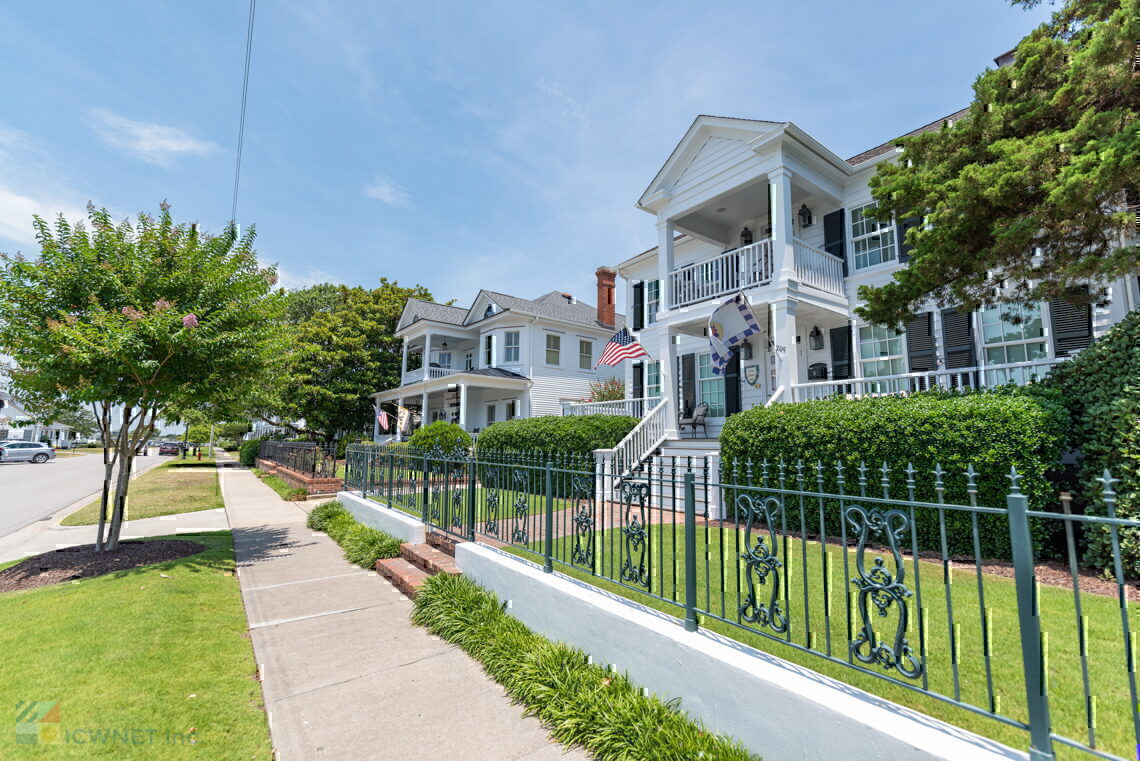Visitors taking a stroll through Beaufort can’t help but admire the collection of historic homes and charming city blocks that have been guarding the waterfront for centuries. Many of these structures are part of the Beaufort Historic District – a collection of buildings that are found within a 12-block area in the picturesque downtown area. Generally concentrated along Front Street, and easy to explore via a downtown walking tour, the Beaufort Historic District is just another enticing element of the town that lures in visitors year after year.

The Roots of Downtown Beaufort
Beaufort has the honor of being the third oldest town in North Carolina, and was officially established in 1709 after years of being known as the less attractive but very valid moniker, “Fish Town.” Starting as a fishing village and a small port community in the late 1600s, the town’s proximity to local sounds and the Atlantic Ocean made it an appealing spot for privateers, shipping vessels, and small-scale commercial fishing operations.
During the first century or two of its existence, the town was a temporary home for a number of merchants and mariners, who often constructed the stylish-at-the-time Bahamian and West Indian-style homes in the heart of the waterfront town. Many of these initial residences still remain, and visitors with a good eye will spot plaques close to the entrance of these houses that indicate the original owners as well as the original date of construction.
By 1713, as the town was starting to truly grow, a “Plan of Beaufort Towne” was created, which outlined the 12-block area closest to the waterfront. Breaking this terrain into small parcels or lots of land, the plan for the downtown remained relatively unchanged and undisturbed for hundreds of years, and is still the primary blueprint of the town’s layout.
While other port communities established around the same timeframe would go on to thrive, like Wilmington, NC and Charleston, SC, Beaufort would remain relatively small throughout its lifetime. The town’s roots of fishing and maritime activities are still prevalent, however, and modern-day mariners are still attracted to this inviting community by the sea.

About the Beaufort Historic District
There are roughly 16 contributing buildings or sites in the Beaufort Historic District that are listed on the National Register of Historic Places, although it should be noted that the Town of Beaufort itself has its own collection of homes that fit the Historic District qualification. The structures include a wide array of architectural styles popular in the 18th and 19th centuries, which includes Greek Revival, Gothic Revival, and Queen Anne influenced buildings.
There are some stand-outs within the homes and sites, such as the Old Burying Ground, which is found in the heart of the downtown, and which is a popular spot on historic walking tours and ghost tours. The Old Burying Ground was established in 1724, making it one of the oldest cemeteries in the state, and features roughly 200 gravesites from the pre-Civil War era, 45 from the Civil War years, and 150 additional stones that are dated before 1900.
Other unique sites within the Beaufort Historic District include the Gibbs House, which was built around 1851, and which was notable as the temporary home of marine scientists from Johns Hopkins University. As a result of this brief occupation, the home became known as the first marine biology research laboratory in the country. Visitors will also want to pause by the Jacob Henry House, which was built around 1794, and which was the original home of Jacob Henry, who made waves in 1809 when he fought for his right as a Jew to hold a state office in North Carolina after being voted to the position.
All in all, while most of the structures within the Beaufort Historic District are relatively simple buildings, with stand-out architectural features that include gable roofs, front porches, chimneys, and mantels, the overall effect is extraordinary. Walking through downtown Beaufort on a quiet afternoon is like taking a little step back in time, as the townscape is remarkably consistent in terms of scale, form, and overall charm.

How to Explore the Beaufort Historic District
Visitors who want to take in the town and learn all the stories behind the homes and sites that comprise the Beaufort Historic District can easily do so via an in-depth tour. A number of historical tours are available through multiple vendors, which can include walking tours, bike tours, boat tours, and even themed expeditions like evening ghost tours. Stop by a local visitors’ center or take a stroll along the docks where multiple tour vendors set up temporary shop in the summer months to learn all about the options available.
Another good starting point for learning more about the ancient homes and sites within the Beaufort Historic District is the Beaufort Historical Association. Located within the primary Beaufort Historic Site building, this local organization can point new visitors on the right path when it comes to a self-guided exploration. In addition, visitors can take the opportunity to discover the unique structures within the Beaufort Historic Site itself, or can book a town-wide tour in an authentic English double decker bus.
There are also a number of resources for exploring that are available online. The Town of Beaufort’s Historic Preservation Commission (HPC) is a seven member panel whose goal is to identify, protect, and help preserve the historic architectural resources - and the historical setting - of Beaufort. They have a nicely detailed flier which outlines the criteria for a home that meets the Historic District designation, which is found here, and the HFC is a solid resource for homeowners and new owners who want to see if their home meets the requirements for being named a historical addition to the town’s landscape.
But, for the most part, visitors who want to casually explore the Beaufort Historic District will simply want to step outside and go for a stroll. Start with Front Street, which hugs the borders of Taylor’s Creek, and then wind through the 12-block downtown area to discover a collection of architectural treasures. Visitors will want to keep an eye out for small signs and plaques that indicate a home or property of significance, as well as the NC Historical Markers which are found throughout this centuries-old community.
The Beaufort Historic District is a fascinating component of the town in more ways than one. Featuring subtle but striking architecture, historical elements, and tons of fascinating stories of local residents from a bygone era, these homes help Beaufort maintain its inherent beauty and charm. Enjoy a lazy walking expedition, or embark on a tour for a more in-depth perspective, and discover just how enticing and beautiful local history can be.





Jump aboard the pirate ship "REVENGE" at 600 Front Street in Beaufort, North Carolina. Our interactive voyages offer fun and adventure for families and swashbucklers of all ages. Come join our crew, take part in a pirate adventure, and enjoy festive...
Discover a treasure or two to serve as a timeless reminder of your getaway to the Crystal Coast with a visit to one of the most unique jewelry stores in the Carteret County region, J Chalk Designs. Specializing in fine pieces that are truly one of a...
Visitors of all ages will have a blast at this destination that is designed for great times along the Crystal Coast shoreline. Professor Hacker's Lost Treasure Golf and Raceway is situated in the centrally located beach community of Salter Path, and...
Visitors can enjoy the Crystal Coast’s most coveted and hard-to-reach shorelines, or just embark on a breezy cruise of the open waters in search of dolphins and sunsets, with a trip that’s guided by Lookout Cruises. This local tour...
Island Express Ferry Service LLC is the only authorized concessionaire to drop off at Cape Lookout Lighthouse and Shackleford Banks! Offering departures from both Beaufort and nearby Harkers Island, Island Express Ferry Service serves as the...






